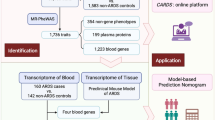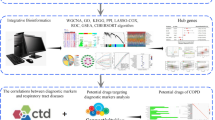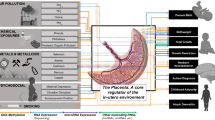Abstract
Early-onset preeclampsia (EOPE) is a complex pregnancy complication that poses significant risks to the health of both mothers and fetuses, and research on its pathogenesis and pathophysiology remains insuffcient. This study aims to explore the role of candidate genes and their potential interaction mechanisms in EOPE through bioinformatics analysis techniques. Two gene expression datasets, GSE44711 and GSE74341, were obtained from the Gene Expression Omnibus (GEO) to identify differentially expressed genes (DEGs) between EOPE and gestational age-matched preterm control samples. Functional enrichment analysis was performed utilizing the kyoto encyclopedia of genes and genomes (KEGG), gene ontology (GO), and gene set enrichment analysis (GSEA). A protein–protein interaction (PPI) network was constructed using the STRING database, and hub DEGs were identified through Cytoscape software and comparative toxicogenomics database (CTD) analysis. Furthermore, a diagnostic logistic model was established using these hub genes, which were confirmed through reverse transcription polymerase chain reaction (RT-PCR). Finally, immune cell infiltration was analyzed using CIBERSORT. In total, 807 DEGs were identified in the GSE44711 dataset (451 upregulated genes and 356 downregulated genes), and 787 DEGs were identified in the GSE74341 dataset (446 upregulated genes and 341 downregulated genes). These DEGs were significantly enriched in various molecular functions such as extracellular matrix structural constituent, receptor-ligand activity binding, cytokine activity, and platelet-derived growth factor. KEGG and GSEA annotation revealed significant enrichment in pathways related to ECM-receptor interaction, PI3K-AKT signaling, and focal adhesion. Ten hub genes were identified through the CytoHubba plugin in Cytoscape. Among these hub genes, three key DEGs (COL1A1, SPP1, and THY1) were selected using CTD analysis and various topological methods in Cytoscape. The diagnostic logistic model based on these three genes exhibited high efficiency in predicting EOPE (AUC = 0.922). RT-PCR analysis confirmed the downregulation of these genes in EOPE, and immune cell infiltration analysis suggested the significant role of M1 and M2 macrophages in EOPE. In conclusion, this study highlights the association of three key genes (COL1A1, SPP1, and THY1) with EOPE and their contribution to high diagnostic efficiency in the logistic model. Additionally, it provides new insights for future research on EOPE and emphasizes the diagnostic value of these identified genes. More research is needed to explore their functional and diagnostic significance in EOPE.





Similar content being viewed by others
Data Availability
The datasets generated and analyzed during the current study are available in the Gene Expression Omnibus (GEO) database. (https://www.ncbi.nlm.nih.gov/geo/query/acc.cgi?acc=GSE74341; https://www.ncbi.nlm.nih.gov/geo/query/acc.cgi?acc=GSE44711).
Abbreviations
- PE:
-
Preeclampsia
- EOPE:
-
Early-onset preeclampsia
- GEO:
-
Gene expression omnibus
- DEGs:
-
Differentially expressed genes
- GO:
-
Gene ontology
- KEGG:
-
Kyoto encyclopedia of genes and genomes
- GSEA:
-
Gene set enrichment analysis
- PPI:
-
Protein–protein interaction
- PCA:
-
Principal component analysis
- ROC:
-
Receiver operating characteristic
- CTD:
-
Comparative toxicogenomics database
- ECM:
-
Extracellular matrix
References
Aneman I, Pienaar D, Suvakov S et al (2020) Mechanisms of key innate immune cells in early-and late-onset preeclampsia. Front Immunol 11:1864. https://doi.org/10.3389/fimmu.2020.01864
Blair JD, Yuen RK, Lim BK et al (2013) Widespread DNA hypomethylation at gene enhancer regions in placentas associated with early-onset pre-eclampsia. Mol Hum Reprod 19:697–708. https://doi.org/10.1093/molehr/gat044
Burton GJ, Redman CW, Roberts JM et al (2019) Pre-eclampsia: pathophysiology and clinical implications. BMJ. https://doi.org/10.1136/bmj.l2381
Cirkovic A, Garovic V, Milin Lazovic J et al (2020) Systematic review supports the role of DNA methylation in the pathophysiology of preeclampsia: a call for analytical and methodological standardization. Biol Sex Differ 11:1–17. https://doi.org/10.1186/s13293-020-00313-8
Cudmore MJ, Ahmad S, Sissaoui S et al (2012) Loss of Akt activity increases circulating soluble endoglin release in preeclampsia: identification of inter-dependency between Akt-1 and heme oxygenase-1. Eur Heart J 33:1150–1158. https://doi.org/10.1093/eurheartj/ehr065
Erikson DW, Burghardt RC, Bayless KJ et al (2009) Secreted phosphoprotein 1 (SPP1, osteopontin) binds to integrin alphavbeta6 on porcine trophectoderm cells and integrin alphavbeta3 on uterine luminal epithelial cells, and promotes trophectoderm cell adhesion and migration. Biol Reprod 81:814–825. https://doi.org/10.1095/biolreprod.109.078600
Faas MM, De Vos P (2018) Innate immune cells in the placental bed in healthy pregnancy and preeclampsia. Placenta 69:125–133. https://doi.org/10.1016/j.placenta.2018.04.012
Faas MM, Spaans F, De Vos P (2014) Monocytes and macrophages in pregnancy and pre-eclampsia. Front Immunol 5:298. https://doi.org/10.3389/fimmu.2014.00298
Fang S, Dai Y, Mei Y et al (2019) Clinical significance and biological role of cancer-derived type I collagen in lung and esophageal cancers. Thoracic Cancer 10:277–288. https://doi.org/10.1111/1759-7714.12947
Gabinskaya T, Salafia CM, Gulle VE et al (1998) Gestational age-dependent extravillous cytotrophoblast osteopontin immunolocalization differentiates between normal and preeclamptic pregnancies. Am J Reprod Immunol 40:339–346. https://doi.org/10.1111/j.1600-0897.1998.tb00063.x
Goddard KAB, Tromp G, Romero R et al (2007) Candidate-gene association study of mothers with pre-eclampsia, and their infants, analyzing 775 SNPs in 190 genes. Hum Hered 63:1–16. https://doi.org/10.1159/000097926
Gu Z, Eils R, Schlesner M (2016) Complex heatmaps reveal patterns and correlations in multidimensional genomic data. Bioinformatics 32:2847–2849. https://doi.org/10.1093/bioinformatics/btw313
Guillomot M, Campion E, Prézelin A et al (2014) Spatial and temporal changes of decorin, type I collagen and fibronectin expression in normal and clone bovine placenta. Placenta 35:737–747. https://doi.org/10.1016/j.placenta.2014.06.366
Gurung S, Greening DW, Rai A et al (2021) The proteomes of endometrial stromal cell-derived extracellular vesicles following a decidualizing stimulus define the cells’ potential for decidualization success. Mol Hum Reprod 27:gaab057. https://doi.org/10.1093/molehr/gaab057
He Y, Sun MM, Zhang GG et al (2021) Targeting PI3K/Akt signal transduction for cancer therapy. Signal Transduct Target Ther 6:425. https://doi.org/10.1038/s41392-021-00828-5
Herington JL, Bany BM (2007) The conceptus increases secreted phosphoprotein 1 gene expression in the mouse uterus during the progression of decidualization mainly due to its effects on uterine natural killer cells. Reproduction 133:1213–1221. https://doi.org/10.1530/REP-07-0085
Hernandez SC, Hogg CO, Billon Y et al (2013) Secreted phosphoprotein 1 expression in endometrium and placental tissues of hyperprolific large white and meishan gilts. Biol Reprod 88(120):1–7. https://doi.org/10.1095/biolreprod.112.104679
Hu H, Ma J, Li Z et al (2022) CyPA interacts with SERPINH1 to promote extracellular matrix production and inhibit epithelial-mesenchymal transition of trophoblast via enhancing TGF-β/Smad3 pathway in preeclampsia. Mol Cell Endocrinol 548:111614. https://doi.org/10.1016/j.mce.2022.111614
Hu J, Guo Q, Liu C et al (2022) Immune cell profiling of preeclamptic pregnant and postpartum women by single-cell RNA sequencing. Int Rev Immunol. https://doi.org/10.1080/08830185.2022.2144291
Hutter S, Heublein S, Knabl J et al (2013) Macrophages: are they involved in endometriosis, abortion and preeclampsia and how? J Nippon Med Sch 80:97–103. https://doi.org/10.1272/jnms.80.97
Ibrahim T, Przybyl L, Harmon AC et al (2017) Proliferation of endogenous regulatory T cells improve the pathophysiology associated with placental ischaemia of pregnancy. Am J Reprod Immunol 78:e12724. https://doi.org/10.1111/aji.12724
Jiang Y, Zhu Y, Shi Y et al (2013) Downregulation of SPARC expression inhibits the invasion of human trophoblast cells in vitro. PLoS ONE 8:e69079. https://doi.org/10.1371/journal.pone.0069079
Kanehisa M, Goto S (2000) KEGG: kyoto encyclopedia of genes and genomes. Nucleic Acids Res 28:27–30. https://doi.org/10.1093/nar/28.1.27
Kelemu T, Erlandsson L, Seifu D et al (2020) Association of maternal regulatory single nucleotide polymorphic CD99 genotype with preeclampsia in pregnancies carrying male fetuses in Ethiopian women. Int J Mol Sci 21:5837. https://doi.org/10.3390/ijms21165837
Li S, Li H, Xu Y et al (2017) Identification of candidate biomarkers for epithelial ovarian cancer metastasis using microarray data. Oncol Lett 14:3967–3974. https://doi.org/10.3892/ol.2017.6707
Li T, Zhang L, Jin C et al (2020) Pomegranate flower extract bidirectionally regulates the proliferation, differentiation and apoptosis of 3T3-L1 cells through regulation of PPARγ expression mediated by PI3K-AKT signaling pathway. Biomed Pharmacother 131:110769. https://doi.org/10.1016/j.biopha.2020.110769
Li Y, Sun X-l, Ma C-l et al (2021) STX2 Promotes trophoblast growth, migration, and invasion through activation of the PI3K-AKT pathway in preeclampsia. Front Cell Dev Biol 9:615973. https://doi.org/10.3389/fcell.2021.615973
Li T, Ling Z, Xie K et al (2021b) The COL-4A1 polypeptide destroy endothelial cells through the TGF-β/PI3K/AKT pathway. Sci Rep 11:15761. https://doi.org/10.1038/s41598-021-94801-5
Liang M, Niu J, Zhang L et al (2016) Gene expression profiling reveals different molecular patterns in G-protein coupled receptor signaling pathways between early-and late-onset preeclampsia. Placenta 40:52–59. https://doi.org/10.1016/j.placenta.2016.02.015
Liu J, Shen J-X, Wu H-T et al (2018) Collagen 1A1 (COL1A1) promotes metastasis of breast cancer and is a potential therapeutic target. Discov Med 25:211–223. https://doi.org/10.1038/s41598-021-94801-5
Ma K, Jin H, Hu R et al (2014) A proteomic analysis of placental trophoblastic cells in preeclampsia-eclampsia. Cell Biochem Biophys 69:247–258. https://doi.org/10.1007/s12013-013-9792-4
Mancarella S, Serino G, Gigante I et al (2022) CD90 is regulated by notch1 and hallmarks a more aggressive intrahepatic cholangiocarcinoma phenotype. J Exp Clin Cancer Res 41:1–16. https://doi.org/10.1186/s13046-022-02283-8
Mi H, Muruganujan A, Ebert D et al (2019) PANTHER version 14: more genomes, a new PANTHER GO-slim and improvements in enrichment analysis tools. Nucleic Acids Res 47:D419–D426. https://doi.org/10.1093/nar/gky1038
Newman AM, Liu CL, Green MR et al (2015) Robust enumeration of cell subsets from tissue expression profiles. Nat Methods 12:453–457. https://doi.org/10.1038/nmeth.3337
Ning F, Liu H, Lash GE (2016) The role of decidual macrophages during normal and pathological pregnancy. Am J Reprod Immunol 75:298–309. https://doi.org/10.1111/aji.12477
Park SH, Goo JM, Jo C-H (2004) Receiver operating characteristic (ROC) curve: practical review for radiologists. Korean J Radiol 5:11–18. https://doi.org/10.3348/kjr.2004.5.1.11
Ritchie ME, Phipson B, Wu D et al (2015) limma powers differential expression analyses for RNA-sequencing and microarray studies. Nucleic Acids Res 43:e47–e47. https://doi.org/10.1093/nar/gkv007
Roberts J, Cooper DW (2001) Pathogenesis and genetics of pre-eclampsia. The Lancet 357:53–56. https://doi.org/10.1016/S0140-6736(00)03577-7
Roberts JM, Hubel CA (2009) The two stage model of preeclampsia: variations on the theme. Placenta 30:32–37. https://doi.org/10.1016/j.placenta.2008.11.009
Salvany-Celades M, van der Zwan A, Benner M et al (2019) Three types of functional regulatory T cells control T cell responses at the human maternal-fetal interface. Cell Rep 27:2537-2547.e5. https://doi.org/10.1016/j.celrep.2019.04.109
Schonkeren D, van der Hoorn M-L, Khedoe P et al (2011) Differential distribution and phenotype of decidual macrophages in preeclamptic versus control pregnancies. Am J Pathol 178:709–717. https://doi.org/10.1016/j.ajpath.2010.10.011
Xia J, Qiao F, Su F et al (2009) Implication of expression of osteopontin and its receptor integrin ανβ3 in the placenta in the development of preeclampsia. J Huazhong Univ Sci Technol 29:755–760. https://doi.org/10.1007/s11596-009-0617-z
Xu Y, Sui L, Qiu B et al (2019) ANXA4 promotes trophoblast invasion via the PI3K/Akt/eNOS pathway in preeclampsia. Am J Physiol Cell Physiol 316:C481–C491. https://doi.org/10.1152/ajpcell.00404.2018
Yang F, Zheng Q, Jin L (2019) Dynamic function and composition changes of immune cells during normal and pathological pregnancy at the maternal-fetal interface. Front Immunol 10:2317. https://doi.org/10.3389/fimmu.2019.02317
Yi Y, Zhu H, Klausen C et al (2021) Dysregulated BMP2 in the placenta may contribute to early-onset preeclampsia by regulating human trophoblast expression of extracellular matrix and adhesion molecules. Front Cell Dev Biol. https://doi.org/10.3389/fcell.2021.768669
Yu G, Wang L-G, Han Y et al (2012) clusterProfiler: an R package for comparing biological themes among gene clusters. OMICS 16:284–287. https://doi.org/10.1089/omi.2011.0118
Acknowledgements
The authors thank the researchers who uploaded sequencing data to the public databases and everyone who helped in this study.
Funding
This work was supported by the National Natural Science Foundation of Fujian Province (Nos. 2021J01243, 2020J01937), Fujian Provincial Health Technology Project (No. 2020CXB024), Education and Research Foundation for Young and Middle-aged Teachers of Fujian Province (No. JT180581), Monographic Research Foundation of Fujian Jiangxia University (No. JXZ2018008).
Author information
Authors and Affiliations
Contributions
FZ and LH conceived and designed the study. FZ and JW analyzed and interpreted the data. FZ, JW, XW, and LH verified the data. FZ and LH associated all the statistical analysis. FZ, JW, XW, and LH prepared figures and wrote the manuscript. All authors contributed to editorial changes in the manuscript. All authors read and approved the final manuscript.
Corresponding author
Ethics declarations
Competing interests
The authors declare that they have no competing interests.
Ethical Approval
Written consent was obtained from all participants, and our study was authorized by the institutional human experiment and ethics committee of the First Affiliated Hospital of Fujian Medical University (Approval No. MRCTA, ECFAH of FMU(2020) 329).
Consent for Publication
Not applicable.
Additional information
Publisher's Note
Springer Nature remains neutral with regard to jurisdictional claims in published maps and institutional affiliations.
Supplementary Information
Below is the link to the electronic supplementary material.
Rights and permissions
Springer Nature or its licensor (e.g. a society or other partner) holds exclusive rights to this article under a publishing agreement with the author(s) or other rightsholder(s); author self-archiving of the accepted manuscript version of this article is solely governed by the terms of such publishing agreement and applicable law.
About this article
Cite this article
Zhan, F., He, L., Wu, J. et al. Bioinformatic Analysis Identifies Potential Extracellular Matrix Related Genes in the Pathogenesis of Early Onset Preeclampsia. Biochem Genet 62, 646–665 (2024). https://doi.org/10.1007/s10528-023-10461-2
Received:
Accepted:
Published:
Issue Date:
DOI: https://doi.org/10.1007/s10528-023-10461-2




